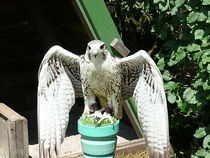Iceland falcon
The bird's common comes from French gerfaucon, and in medieval Latin is rendered as gyrofalco. The first part of the word may come from Old High German gîr , vulture, referring to its size compared to other falcons, or the Latin gȳrus from the species' circling as it searches for prey, unlike the other falcons in its range. The male gyrfalcon is called a gyrkin in falconry. The scientific name is composed of the Latin terms for a falcon, Falco, and, for someone who lives in the countryside, rusticolus.
The Iceland falcon is classified as Least Concern. Does not qualify for a more at risk category. Widespread and abundant taxa are included in this category.
Iceland FalconIceland FalconIceland Falcon To use any of the clipart images above (including the thumbnail image in the top left corner), just click and drag the picture to your desktop. You may also control-click (Mac) or right-click (Windows) and choose "Save file to disk" from the pop-up menu. Click here for help downloading and using clipart files. More
also known as: Iceland Falcon & Greenland Falcon This, the largest of all the falcons is very rarely seen due it's prefered habitat. Appearance: Possibly due to its large area that it inhabits, and the different cover that it can find, the Gyr falcon has many different forms, this is why it was given many names, as the individuals appeared to different. More
Gyr Falcon & Iceland Falcon Skeletonzoom in on this image|Find images that look like this one | There are 2 views of this object. Gyr Falcon & Iceland Falcon Skeleton alternative view 1|Gyr Falcon & Iceland Falcon Skeleton alternative view 2| Gyr Falcon & Iceland Falcon Skeleton (Chordata, Aves, Falconiformes, Falconidae, Falco Rusticolus) This is the skeleton of a female bird, an Iceland Falcon. John Hancock had several specimens of this subspecies sent to him from Norway and Iceland. More

Original source: Artur Nowak
Author: Artur Nowak
Permission: Some rights reserved
Family : Falconidae
Genus : Falco
Species : rusticolus
Authority : Linnaeus, 1758

